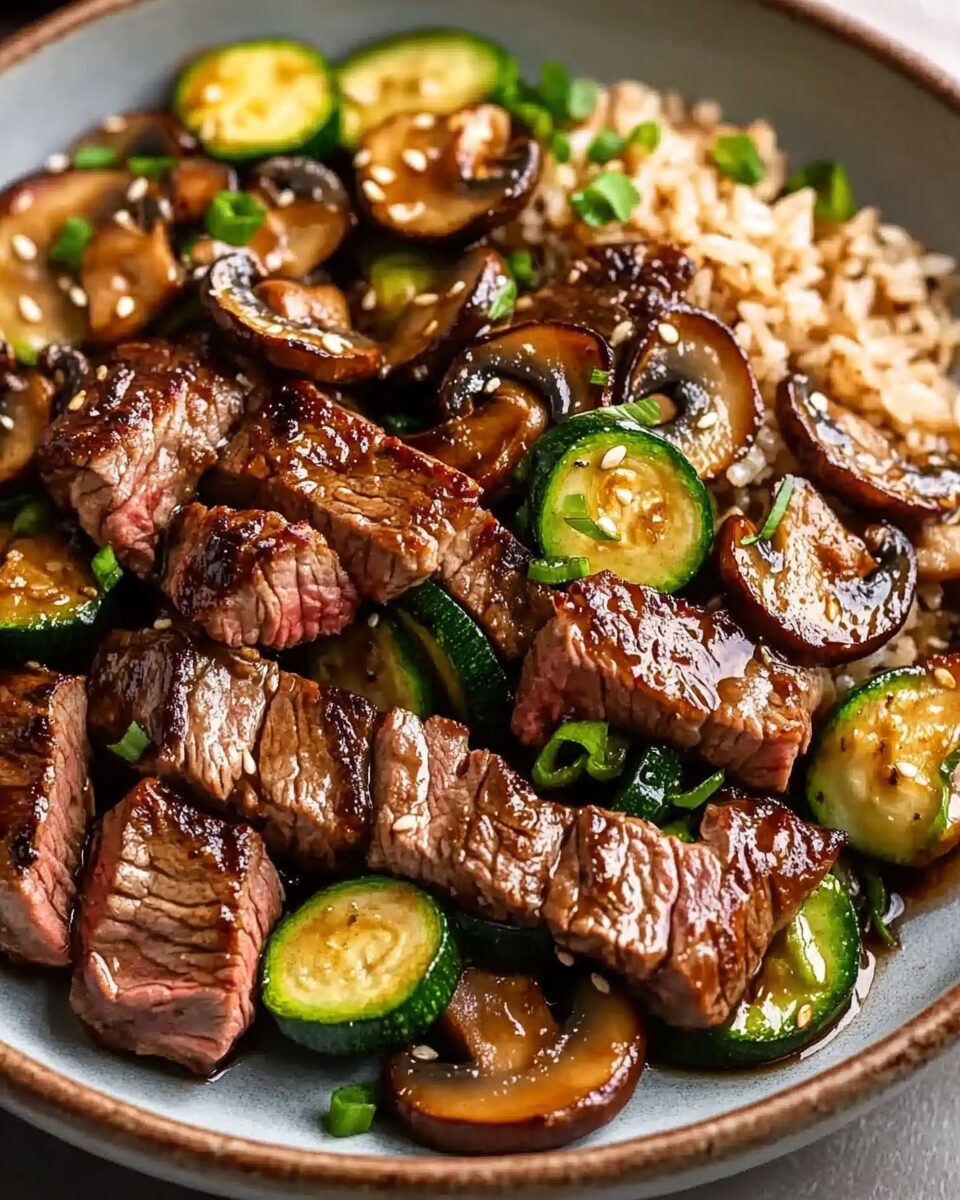The Perfect Steak: Sear, Tender, and Flavorful
The foundation of this dish is the steak—cut into bite-sized cubes for quick, even cooking and easy eating. Sirloin and New York strip are excellent choices due to their tender texture and rich beefy flavor. The high-heat sear locks in juices and creates a caramelized crust, a hallmark of hibachi-style steak. With just salt and pepper to season initially, the steak is allowed to shine on its own before being reunited with the sauce and vegetables.
By cutting the steak into chunks before cooking, each piece gets optimal browning, and the high surface area means it absorbs more of the flavorful garlic soy glaze. The searing process only takes a few minutes per side, preserving the steak’s tenderness and ensuring a juicy bite every time.
Vegetable Medley: A Balanced, Satisfying Addition
Traditional hibachi dishes include a hearty helping of sautéed vegetables, and this recipe delivers with a satisfying trio of mushrooms, onions, and zucchini. These veggies are cooked just long enough to develop flavor and tenderness while maintaining a slight crunch. Their mild sweetness pairs beautifully with the rich steak and the umami-rich sauce.
Mushrooms bring earthy depth, onions offer subtle sweetness, and zucchini adds freshness and a soft bite. Cooking them in a mix of vegetable oil and sesame oil enhances their flavor while lending a subtle nuttiness that echoes the dish’s Japanese inspiration.
The Signature Garlic Soy Butter Sauce
What truly defines this hibachi steak recipe is the luscious garlic soy butter glaze. Built from a simple base of soy sauce, mirin (a lightly sweet Japanese rice wine), and honey, this sauce blends saltiness, sweetness, and umami into a glossy glaze that coats each bite.
Garlic is briefly sautéed in butter to bring out its aromatic punch before the sauce is added to the skillet. The steak is then returned to the pan, where everything gets tossed together and simmered just long enough for the sauce to thicken slightly and coat all the ingredients. The final addition of a pat of butter enriches the glaze and gives the dish that irresistible silky texture found in restaurant hibachi dishes.
Quick, One-Pan Cooking for Everyday Ease
One of the best things about this recipe is how fast and simple it is to prepare. In less than 30 minutes, you can have a full-flavored, nutrient-rich meal on the table. It’s cooked entirely in one pan, which minimizes cleanup while maximizing flavor development. The steak, vegetables, and sauce all build upon each other in stages, creating layers of taste without the need for complex techniques or ingredients.
Whether you’re cooking for one, two, or a crowd, this recipe scales easily and adapts well. Double the ingredients for a family meal or halve them for a quick solo dinner. It also reheats beautifully, making leftovers a joy.
Serving Suggestions and Custom Pairings
This hibachi steak pairs wonderfully with classic Japanese-style sides:
-
Hibachi fried rice: Toss cooked rice in a bit of oil, soy sauce, scrambled egg, and scallions for a perfect side.
-
Steamed white rice or jasmine rice: A neutral base to soak up all that flavorful sauce.
-
Yum Yum sauce: This creamy, slightly sweet mayo-based condiment is the classic hibachi pairing.
-
Sautéed noodles: Swap rice for soba or udon noodles for a delicious twist.
For a lighter option, pair the steak with cauliflower rice or serve it over a bed of mixed greens for a steak salad with an Asian flair. Add a few slices of avocado or drizzle with spicy mayo to build on the hibachi-house feel.
Garnishes like toasted sesame seeds, sliced green onions, or even a splash of fresh lime juice enhance both the flavor and presentation of the dish.
Flavor Variations and Ingredient Substitutions
Want to make this recipe your own? Here are a few quick swaps and additions:
-
Protein swaps: Try it with chicken breast, shrimp, or even tofu for a pescatarian or vegetarian version.
-
Add heat: Stir in a bit of sriracha, chili garlic sauce, or red pepper flakes if you want a spicy kick.
-
Add crunch: A sprinkle of crushed peanuts or cashews can add texture and a nutty finish.
-
Extra veggies: Bell peppers, snap peas, or baby corn are excellent additions if you want to boost your vegetable intake.
This flexibility makes the recipe not just delicious but also adaptable for different tastes and dietary needs.
Nutritional Snapshot and Balanced Indulgence
Each serving of this Hibachi Steak dish is approximately 430 calories—balanced across protein, fats, and carbohydrates. With about 28 grams of protein, it supports muscle repair and satiety, while the vegetables provide fiber, vitamins, and antioxidants. The garlic butter soy sauce adds richness, but because it’s portioned evenly over several servings, it doesn’t overwhelm the nutritional balance.
You can lighten the dish further by reducing the butter slightly or using low-sodium soy sauce to control sodium intake. Skipping rice or using cauliflower rice can lower the carbs while keeping all the flavor intact.
Conclusion
This Hibachi Steak recipe brings the bold, satisfying flavors of a Japanese steakhouse into your home kitchen—no teppanyaki grill required. With tender steak, vibrant sautéed vegetables, and a rich garlic soy butter glaze, every bite is packed with flavor and comfort. It’s fast, simple, and endlessly versatile, making it ideal for both busy weeknights and special meals alike.
Whether you’re cooking to impress or just treating yourself to a hearty dinner, this recipe delivers restaurant-level taste with home-cooked ease. Pair it with fried rice, a drizzle of yum yum sauce, and a sprinkle of sesame seeds, and you’ll have a complete hibachi-style feast in under 30 minutes.






